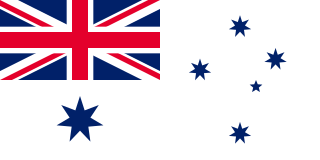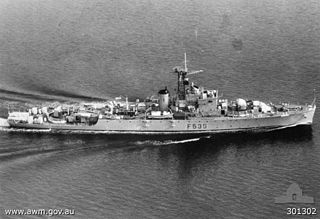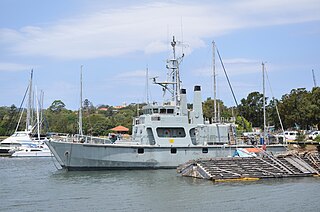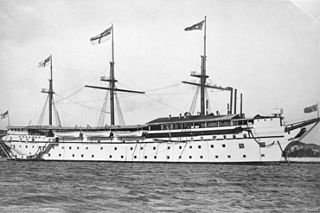
Five ships of the Royal Australian Navy (RAN) have been named HMAS Sydney, after Sydney, the capital city of New South Wales.

The Royal Australian Navy (RAN) is the principal naval force of Australia, a part of the Australian Defence Force (ADF) along with the Australian Army and Royal Australian Air Force. The Navy is commanded by the Chief of Navy (CN), who is subordinate to the Chief of the Defence Force (CDF) who commands the ADF; the current CN is Vice Admiral Michael Noonan. The CN is also directly responsible to the Minister of Defence, with the Department of Defence administering the ADF and the Navy.

HMAS Shoalhaven (K535/M535/F535), named for the Shoalhaven River in New South Wales, was a River-class frigate laid down by Walkers Limited at Maryborough, Queensland, on 18 December 1943, launched on 14 December 1944 by Senator Dorothy Tangney and commissioned at Urangan Pier in Hervey Bay in Queensland on 2 May 1946.
Two ships of the Royal Australian Navy have been named HMAS Jervis Bay, for Jervis Bay on the south coast of New South Wales.
Three ships and two shore installations of the Royal Australian Navy have been named HMAS Penguin after the aquatic, flightless bird:

HMAS Rushcutter was one of two Bay class minehunters built for the Royal Australian Navy by Carrington Slipways at its Ramsay Fibreglass facility in Tomago, New South Wales. She was launched on 8 May 1986 and commissioned on 1 November 1986. She was decommissioned on 14 August 2001. She and sister ship HMAS Shoalwater were sold in 2002 for service in the Persian Gulf. At some point before 2013, the vessel ended up in private hands in Rozelle Bay.
HMAS Shoalwater, named for Shoalwater Bay in Queensland, was a Bay class minehunter of the Royal Australian Navy.

Rear Admiral Sir David James Martin, was a senior officer of the Royal Australian Navy and later Governor of New South Wales. He also established the Sir David Martin Foundation to assist young Australians in crisis.
Three ships of the Royal Australian Navy (RAN) have been named HMAS Wollongong, after the city of Wollongong, New South Wales

HMAS Albatross is the main naval air station for the Royal Australian Navy's (RAN) aviation branch, the Fleet Air Arm. The base, located near Nowra, New South Wales, was formally established in May 1942 as Royal Australian Air Force (RAAF) base RAAF Nowra, then was transferred to the Royal Navy as HMS Nabbington in 1944, and operated as a naval air station until it was decommissioned in late 1945. In 1948, the airfield was commissioned into the RAN as HMAS Albatross, as the primary shore base for the Fleet Air Arm. Since 2011, four squadrons of the Fleet Air Arm operate from Albatross. The current commander of the base is Captain Robyn Phillips, RAN.

HMAS Kuttabul is a Royal Australian Navy (RAN) base located in Potts Point in Sydney, New South Wales, Australia. Kuttabul provides administrative, training, logistics and accommodation support to naval personnel assigned to the various facilities that form Fleet Base East, the main operational navy base on the east coast of Australia. A part of Fleet Base East itself, Kuttabul occupies several buildings in the Sydney suburb of Potts Point and in the immediately adjacent Garden Island dockyard. It also supports navy personnel posted to other locations throughout the greater Sydney region.

The Fleet Base East is a Royal Australian Navy (RAN) major fleet base that comprises several naval establishments and facilities clustered around Sydney Harbour, centred on HMAS Kuttabul. The Fleet Base East extends beyond the borders of Kuttabul and includes the commercially-operated dockyard at Garden Island, and adjacent wharf facilities at nearby Woolloomooloo, east of the Sydney central business district in New South Wales, Australia. Fleet Base East is one of two major facilities of the RAN, the other facility being the Fleet Base West.

HMAS Waterhen is a Royal Australian Navy (RAN) base located in Waverton on Sydney's lower north shore, within Sydney Harbour, in New South Wales, Australia. Constructed on the site of a quarry used to expand Garden Island in the 1930s, the location was used during World War II as a boom net maintenance and storage area. In 1962, the area was commissioned as a base of the RAN, and became home to the RAN's mine warfare forces. Waterhen was the first small-ship base established by the RAN, and from 1969 to 1979 was also responsible for the RAN's patrol boat forces.

The Bay-class Minehunter Inshores were a class of catamaran-hull mine warfare vessels operating with the Royal Australian Navy from 1986. Also referred to as the MHCAT, the class was an attempt to produce a locally designed inshore mine warfare vessel. Two prototype ships were ordered in 1981, with the first ship, Rushcutter, commissioned in November 1986. The two ships experienced delays in construction, and the RAN resorted to acquiring six minesweeper auxiliaries (MSA) under the Craft of Opportunity Program to provide an interim mine-warfare capability, while also keeping Ton-class minesweeper HMAS Curlew in service until 1990, well beyond her intended decommissioning date. The ships did not enter service until 1993, due to problems with the sonar.

HMAS Watson is a Royal Australian Navy (RAN) base on Sydney Harbour at South Head, near Watsons Bay in Sydney, Australia. Commissioned in 1945, the base served as the RAN's radar training school. In 1956, torpedo and anti-submarine warfare training were relocated to the base, and by 2011, Watson was the main maritime warfare training base, as well as providing post-entry education for maritime warfare officers, training for combat system and electronic warfare sailors, and command training.

HMAS Assault is a former Royal Australian Navy (RAN) training centre that was in use during World War II, located at Nelson Bay in the Mid North Coast region of New South Wales, Australia.

HMAS Rushcutter is a former Royal Australian Navy (RAN) base that served as a depot, radar and anti-submarine training school located at Rushcutters Bay and Darling Point, in Sydney's eastern suburbs in New South Wales, Australia.

HMAS Tingira was a training ship operated by the Royal Australian Navy (RAN) between 1911 and 1927. Alexander Hall & Co. built the ship in Scotland in 1866 as the passenger clipper Sobraon; she was the largest composite-hull sailing vessel ever built. She sailed on an annual migration run between England and Australia until 1891, when she was sold to the colonial government of New South Wales for use as a reformatory ship. The vessel was then sold to the federal government in 1911, and entered RAN service. Tingira was paid off in 1927, but despite efforts to preserve the ship, was broken up in 1941.

Adele was a steel screw steamer that was built in 1906 as a yacht. She was twice commissioned into the Royal Australian Navy (RAN), firstly as HMAS Franklin and later as HMAS Adele. She was wrecked at Port Kembla, New South Wales on 7 May 1943.














